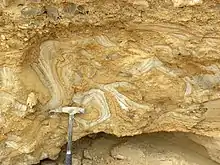A geological event is a temporary and spatially heterogeneous and dynamic (diachronous) happening in Earth history that contributes to the transformation of Earth system and the formation of geological strata. Event stratigraphy was first proposed as a system for the recognition, study and correlation of the effects of important physical or biological events on the broader stratigraphical record.[1]
Geological events range in time span by orders of magnitude, from seconds to millions of years, and in spatial scale from local to regional and, ultimately, global.[2] In contrast to chronostratigraphic or geochronological units, that define the boundaries between periods, epochs and other units of the geologic time scale, complex dynamic diachronous changes are inherent to the event-stratigraphy paradigm. The lithostratigraphic or biostratigraphic boundaries that mark the onset and termination of geological events in the stratigraphic record may be diachronous, whereas those of formal chronostratigraphic or geochronologic units have basal boundaries that are isochronous.
Examples of geological events include a single footprint, an earthquake, a series of volcanic eruptions, the formation of mountains (orogenies), the Great Oxidation Event (GOE) of 2.4-2.0 billion years ago and the Great Ordovician Biodiversification Event (GOBE) ~500 Ma. The event paradigm is firmly embedded in Quaternary science, as the subdivision of quaternary time is based on the recognition of a succession of climatic events, principally glacial and interglacial cycles but also stadials and interstadials. Highly-resolved stratigraphic sequences, such as those from ice cores, provide evidence of much shorter-term millennial-scale climatic events that are superimposed on these broad glacial cycles.[3][4] Other short-term happenings, such as Dansgaard-Oeschger events and Heinrich events, are evident in ice-core sequences and deep-ocean sediment records, respectively.[5][6] Some scientists have proposed that the Anthropocene is more consistent with the concept of a geological event than with a formal chronostratigraphic/geochronological unit, such as an epoch of geologic time.[7][8]
References
- ↑ Ager, D. V. (1973). The Nature of the Stratigraphic Record. Wiley.
- ↑ Rawson, P (2002). Stratigraphical procedure. London: Geological Society. p. 57. ISBN 9781862390942.
- ↑ Rasmussen, Sune O.; Bigler, Matthias; Blockley, Simon P.; Blunier, Thomas; Buchardt, Susanne L.; Clausen, Henrik B.; Cvijanovic, Ivana; Dahl-Jensen, Dorthe; Johnsen, Sigfus J.; Fischer, Hubertus; Gkinis, Vasileios; Guillevic, Myriam; Hoek, Wim Z.; Lowe, J. John; Pedro, Joel B.; Popp, Trevor; Seierstad, Inger K.; Steffensen, Jørgen Peder; Svensson, Anders M.; Vallelonga, Paul; Vinther, Bo M.; Walker, Mike J.C.; Wheatley, Joe J.; Winstrup, Mai (December 2014). "A stratigraphic framework for abrupt climatic changes during the Last glacial interval based on three synchronized Greenland ice-core records: refining and extending the INTIMATE event stratigraphy". Quaternary Science Reviews. 106: 14–28. doi:10.1016/j.quascirev.2014.09.007. hdl:2160/30436. S2CID 55614771.
- ↑ Björck, Svante; Walker, Michael J. C.; Cwynar, Les C.; Johnsen, Sigfus; Knudsen, Karen-Luise; Lowe, J. John; Wohlfarth, Barbara (1998). "An event stratigraphy for the Last Termination in the North Atlantic region based on the Greenland ice-core record: a proposal by the INTIMATE group". Journal of Quaternary Science. 13 (4): 283–292. Bibcode:1998JQS....13..283B. doi:10.1002/(SICI)1099-1417(199807/08)13:4<283::AID-JQS386>3.0.CO;2-A.
- ↑ Dansgaard, W.; Johnsen, S. J.; Clausen, H. B.; Dahl-Jensen, D.; Gundestrup, N. S.; Hammer, C. U.; Hvidberg, C. S.; Steffensen, J. P.; Sveinbjörnsdottir, A. E.; Jouzel, J.; Bond, G. (July 1993). "Evidence for general instability of past climate from a 250-kyr ice-core record" (PDF). Nature. 364 (6434): 218–220. Bibcode:1993Natur.364..218D. doi:10.1038/364218a0. S2CID 4304321.
- ↑ Hemming, Sidney R. (March 2004). "Heinrich events: Massive late Pleistocene detritus layers of the North Atlantic and their global climate imprint: HEINRICH EVENTS". Reviews of Geophysics. 42 (1). doi:10.1029/2003RG000128. S2CID 53526029.
- ↑ Bauer, Andrew M.; Edgeworth, Matthew; Edwards, Lucy E.; Ellis, Erle C.; Gibbard, Philip; Merritts, Dorothy J. (16 September 2021). "Anthropocene: event or epoch?". Nature. 597 (7876): 332. Bibcode:2021Natur.597..332B. doi:10.1038/d41586-021-02448-z. ISSN 0028-0836. PMID 34522014. S2CID 237515330.
- ↑ Gibbard, Philip L.; Bauer, Andrew M.; Edgeworth, Matthew; Ruddiman, William F.; Gill, Jacquelyn L.; Merritts, Dorothy J.; Finney, Stanley C.; Edwards, Lucy E.; Walker, Michael J. C.; Maslin, Mark; Ellis, Erle C. (15 November 2021). "A practical solution: the Anthropocene is a geological event, not a formal epoch". Episodes. 45 (4): 349–357. doi:10.18814/epiiugs/2021/021029. S2CID 244165877.
